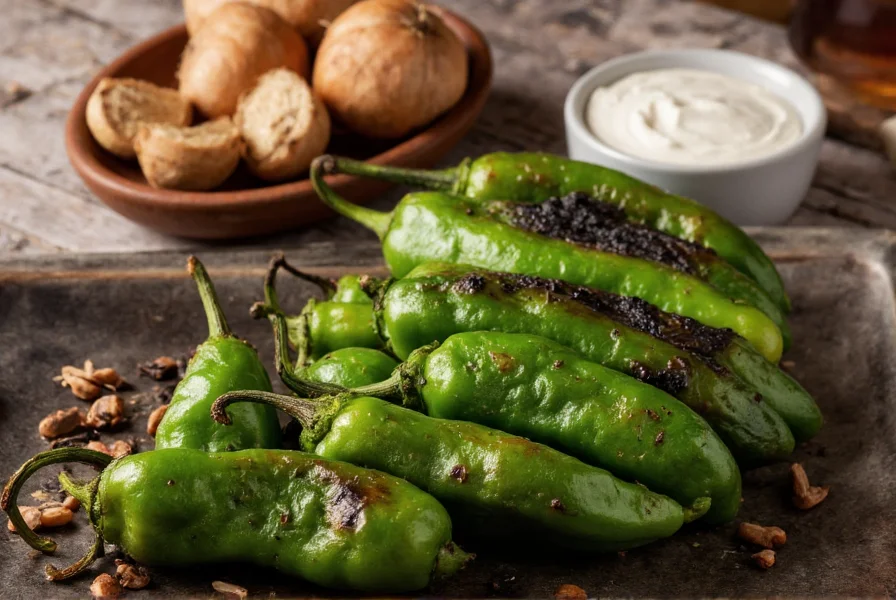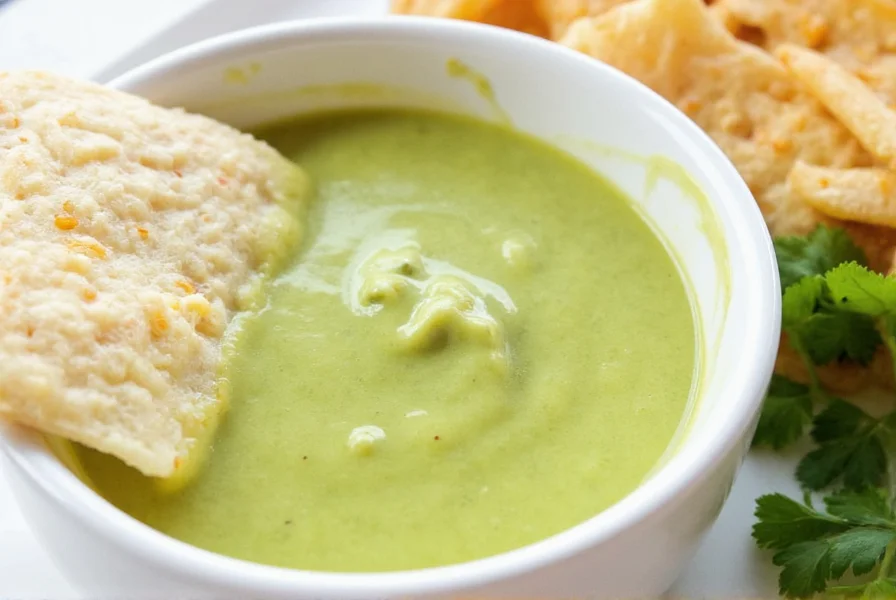Creating the perfect poblano pepper cream sauce begins with understanding this unique Mexican pepper. Poblanos (chiles poblanos) originate from Puebla, Mexico, and offer a distinctive flavor profile that sets them apart from other chili varieties. When properly prepared, this sauce delivers a sophisticated balance of mild heat, earthy notes, and creamy richness that enhances rather than overwhelms dishes.

The Essential Components of Authentic Poblano Cream Sauce
What makes a truly exceptional poblano pepper cream sauce? The magic happens through careful ingredient selection and proper technique. Unlike generic "cream of poblano" recipes, authentic versions respect the pepper's natural characteristics while enhancing its best qualities.
Why Poblano Peppers Shine in Cream Sauces
Poblanos contain capsaicin levels significantly lower than jalapeños (1,000-2,000 SHU versus 2,500-8,000 SHU), making them ideal for creamy preparations where heat shouldn't dominate. Their thick walls and rich flavor profile absorb roasting exceptionally well, developing complex notes of tobacco, raisin, and earth that complement dairy beautifully.
| Pepper Characteristic | Impact on Cream Sauce | Professional Tip |
|---|---|---|
| Thick flesh walls | Retains texture when blended | Roast until 75% blackened for optimal flavor development |
| Low moisture content | Prevents watery sauce | Sweat peppers after roasting to remove excess moisture |
| Earthy flavor profile | Complements dairy notes | Add roasted garlic to enhance earthiness |
| Mild heat level | Allows subtle spice to shine | Include seeds from 1 pepper for balanced heat |
Step-by-Step Preparation Guide
Follow this professional method for restaurant-quality poblano pepper cream sauce at home. This technique maximizes flavor development while maintaining the perfect creamy consistency.
Roasting and Preparing Poblanos
Proper roasting transforms poblano peppers from simple vegetables to flavor powerhouses. Place 4-5 fresh poblanos directly over a gas flame, under a broiler, or on a grill, turning frequently until evenly charred (about 8-10 minutes). Transfer to a covered bowl for 10 minutes to steam, then carefully peel off the blackened skin. Remove stems and seeds, but retain 1-2 seeds for balanced heat.
Building Flavor Foundations
Sauté ½ cup finely diced white onion in 2 tablespoons butter until translucent. Add 2 roasted garlic cloves (pressed) and cook for 1 minute until fragrant. This aromatic base creates depth that simple blending cannot achieve. Deglaze the pan with ¼ cup dry white wine, scraping up any browned bits for maximum flavor extraction.
Creating the Perfect Cream Base
Add the roasted poblanos and 1½ cups chicken or vegetable broth to the sauté pan. Simmer for 10 minutes to meld flavors. Transfer to a blender and add ½ cup heavy cream, ¼ cup Mexican crema (or sour cream), and ½ teaspoon ground cumin. Blend until completely smooth, then return to the pan to simmer gently for 5-7 minutes until thickened to your desired consistency.

Variations and Customization Options
While traditional poblano pepper cream sauce follows specific preparation methods, thoughtful variations can accommodate different dietary needs and flavor preferences without compromising authenticity.
Dietary Adaptations
For a dairy-free poblano cream sauce, substitute coconut cream for heavy cream and use cashew cream instead of Mexican crema. The natural sweetness of coconut complements the pepper's earthiness surprisingly well. For vegan versions, replace chicken broth with mushroom broth to maintain umami depth.
Flavor Enhancements
Professional chefs often incorporate subtle flavor boosters that elevate basic poblano pepper cream sauce. A pinch of Mexican oregano (not Italian oregano) adds earthy complexity, while a small piece of epazote herb provides authentic regional flavor. For special occasions, fold in 2 tablespoons of finely shredded Oaxaca cheese just before serving.
Serving Suggestions and Pairing Ideas
Understanding proper applications transforms poblano pepper cream sauce from a simple condiment to a culinary centerpiece. Traditional Mexican preparations offer the most authentic experiences, while creative modern applications showcase its versatility.
Classic Mexican Pairings
Authentic poblano pepper cream sauce shines in traditional dishes like:
- Chiles Rellenos - Stuffed roasted poblano peppers enveloped in egg batter
- Enchiladas Suizas - Corn tortillas rolled with chicken, topped with sauce and cheese
- Huevos a la Mexicana - Scrambled eggs with tomatoes, onions, and sauce
Modern Culinary Applications
Chefs increasingly use poblano cream sauce in innovative ways:
- As a base for seafood pasta with shrimp and scallops
- Drizzled over grilled salmon or chicken breast
- Thinned for use as a salad dressing with citrus notes
- As a dipping sauce for artisanal tortilla chips
Storage and Shelf Life Guidelines
Proper storage maintains the vibrant color and fresh flavor of homemade poblano pepper cream sauce. When cooled completely and stored in an airtight container, the sauce keeps for 4-5 days in the refrigerator. For longer storage, freeze in ice cube trays then transfer to freezer bags for up to 3 months.
When reheating, do so gently over low heat to prevent separation. If the sauce appears slightly separated after storage, whisk in 1-2 teaspoons of cold cream while warming. Never boil reheated cream sauces, as this causes curdling. For best results, consume within 3 days for optimal flavor and texture.
Troubleshooting Common Issues
Even experienced cooks encounter challenges with poblano pepper cream sauce. Understanding these common problems ensures perfect results every time.
Addressing Texture Problems
If your sauce is too thin, simmer uncovered for 3-5 minutes to reduce. For overly thick sauce, gradually whisk in additional broth or cream, 1 tablespoon at a time. If the sauce appears grainy, strain through a fine-mesh sieve to achieve restaurant-quality smoothness. Never add cold dairy to hot sauce, as this causes separation—always temper dairy by adding small amounts of hot liquid first.
Flavor Balance Adjustments
When the sauce lacks depth, add a pinch of smoked paprika or ¼ teaspoon of ground epazote. For excessive heat, incorporate additional cream and a touch of honey to balance. If the sauce tastes flat, enhance with ½ teaspoon of fresh lime juice added at the end of cooking. Remember that flavors continue to develop as the sauce sits, so adjust seasonings carefully.
Frequently Asked Questions
Can I use canned poblano peppers for cream sauce?
While fresh poblanos produce superior flavor, you can use canned roasted poblano peppers in a pinch. Drain and rinse them thoroughly to remove brine flavors, then proceed with the recipe. Expect slightly less complex flavor and potentially softer texture compared to fresh-roasted peppers. For best results, supplement canned peppers with one fresh roasted poblano to boost flavor depth.
How can I make poblano cream sauce less spicy without losing flavor?
To reduce heat while maintaining flavor in poblano pepper cream sauce, remove all seeds and membranes from the peppers before roasting. Add sweetness with 1 teaspoon of honey or roasted corn puree, which balances heat without masking the pepper's earthy notes. Dairy content naturally tempers heat, so increasing cream proportion slightly (up to ¾ cup) helps. Remember that poblano heat varies by season—spring harvests tend to be milder than fall.
What's the difference between poblano cream sauce and ranchero sauce?
Poblano cream sauce features roasted poblano peppers blended with dairy for a smooth, mild, creamy texture, while ranchero sauce is a tomato-based sauce with multiple chilies including jalapeños or serranos, creating a chunkier, tangier, and typically spicier preparation. Cream sauce serves as a rich complement to delicate dishes, whereas ranchero sauce functions as a bold topping. The fundamental difference lies in the base ingredients—dairy versus tomatoes—and resulting flavor profiles.
Can I prepare poblano cream sauce ahead of time?
Yes, poblano cream sauce actually benefits from advance preparation as flavors meld during refrigeration. Make it 1-2 days ahead and store in an airtight container. The sauce may thicken when chilled—simply thin with additional broth or cream when reheating. For best color retention, press plastic wrap directly onto the sauce surface before refrigerating to prevent oxidation. Avoid freezing if possible, as dairy-based sauces can separate upon thawing.











 浙公网安备
33010002000092号
浙公网安备
33010002000092号 浙B2-20120091-4
浙B2-20120091-4